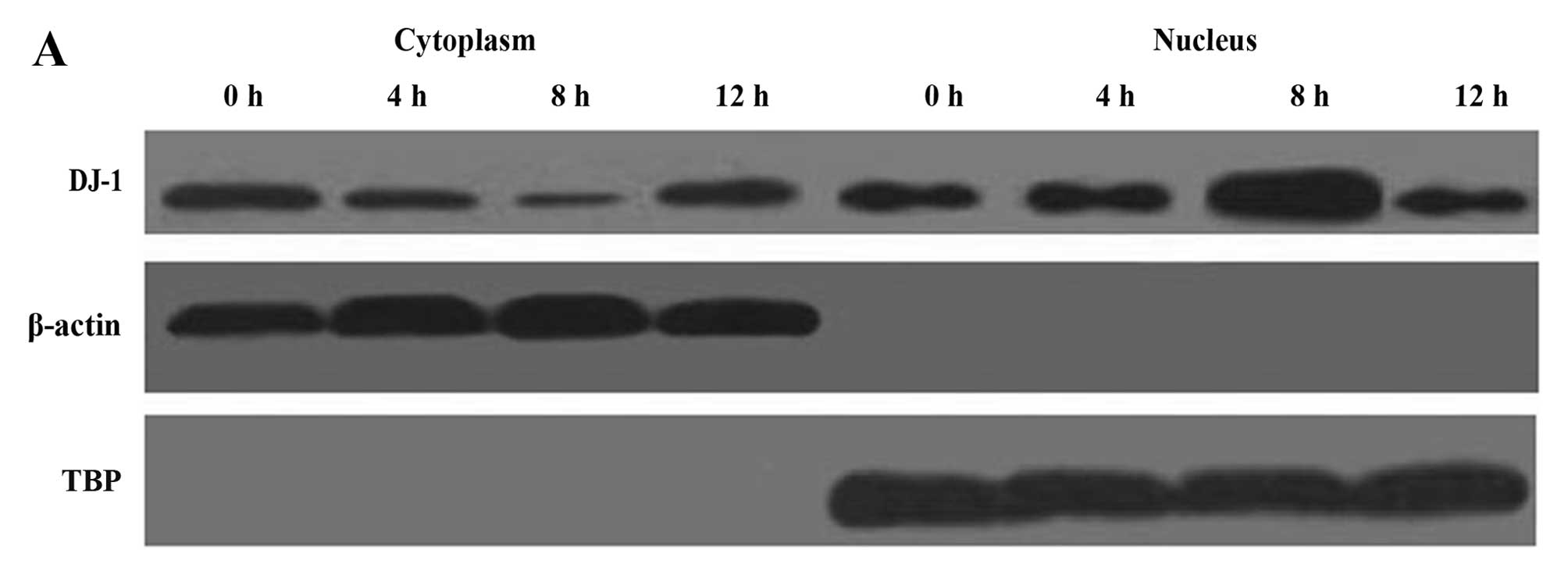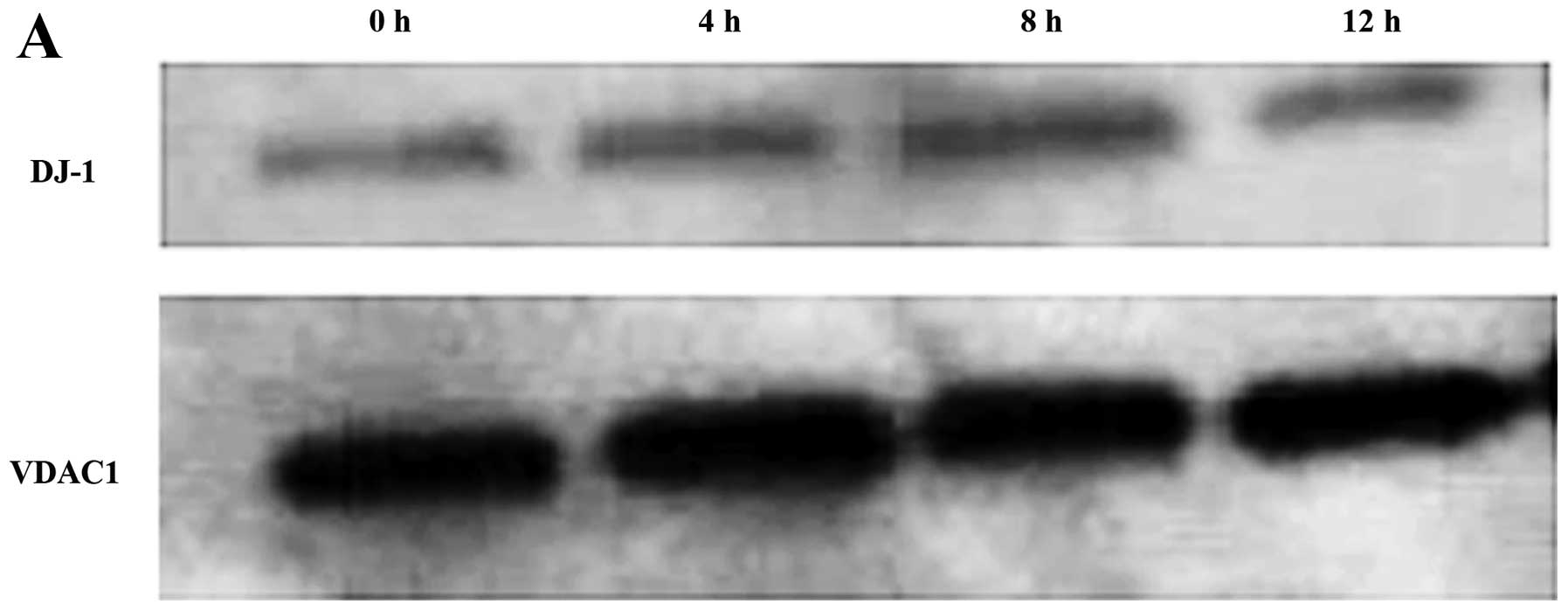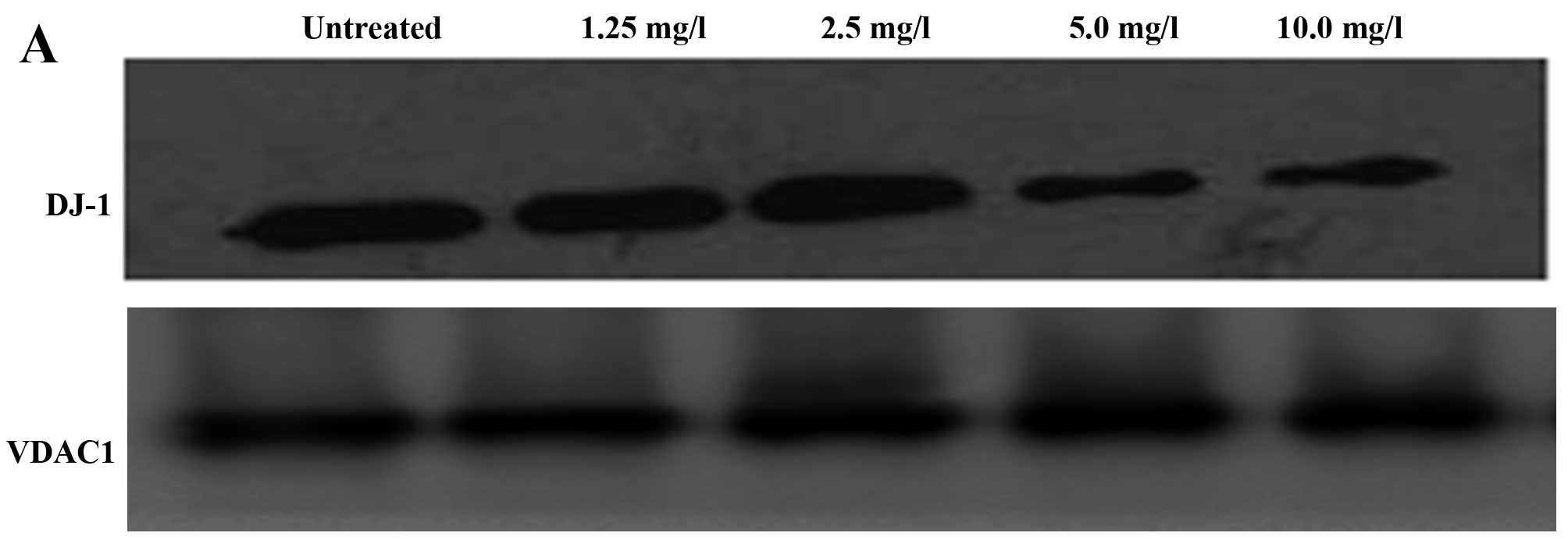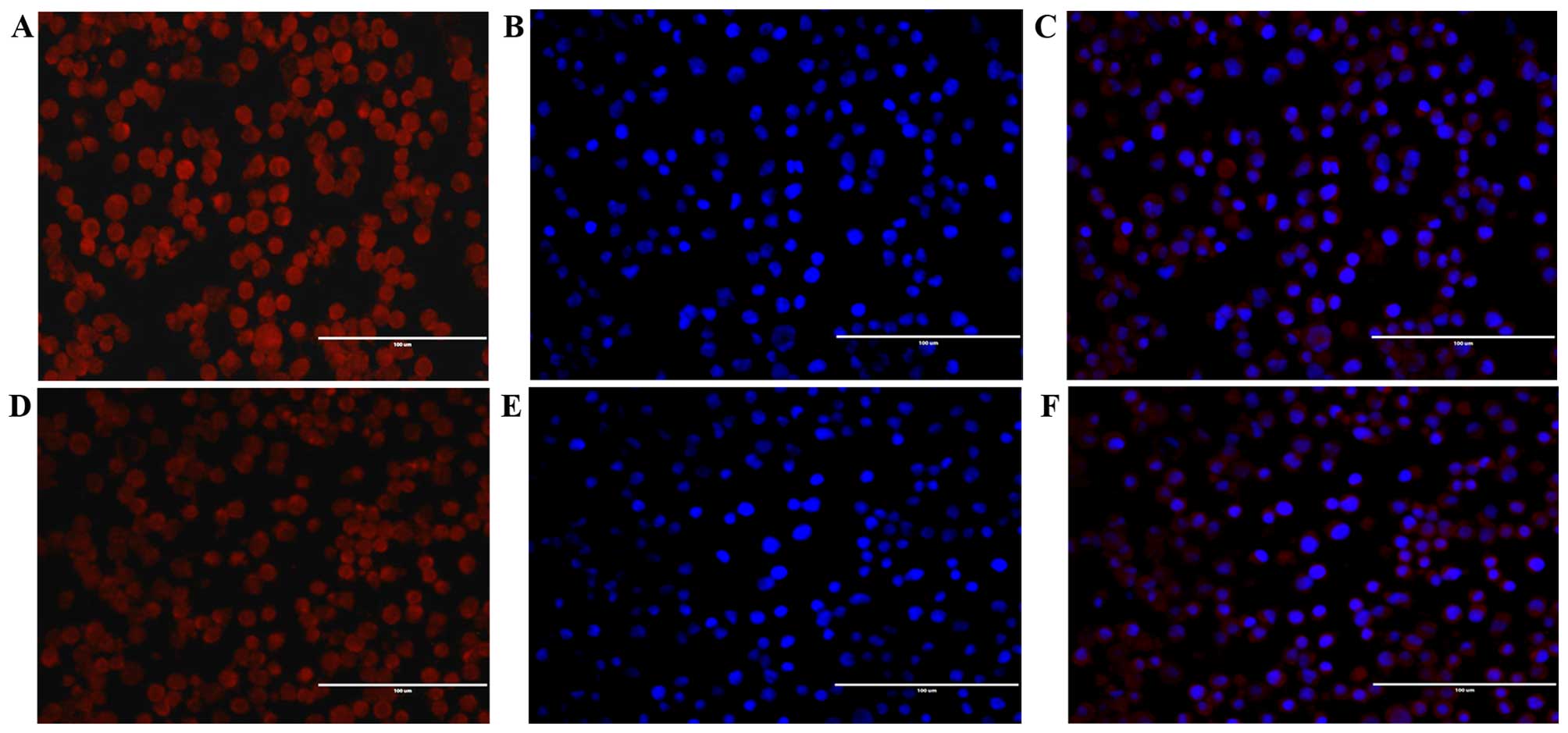|
1
|
Estey E and Döhner H: Acute myeloid
leukemia. Lancet. 368:1894–1907. 2006. View Article : Google Scholar : PubMed/NCBI
|
|
2
|
Jabbour EJ, Estey E and Kantarjian HM:
Adult acute myeloid leukemia. Mayo Clin Proc. 81:247–260. 2006.
View Article : Google Scholar : PubMed/NCBI
|
|
3
|
Chen GQ, Zhao Q, Wu YL and Wang LS:
Chemical biology study for differentiation and apoptosis of
leukemic cell. Shanghai Di-Er Yike Daxue Xuebao. 32:1145–1155.
2012.(In Chinese).
|
|
4
|
Tsiftsoglou AS, Pappas IS and Vizirianakis
IS: Mechanisms involved in the induced differentiation of leukemia
cells. Pharmacol Ther. 100:257–290. 2003. View Article : Google Scholar : PubMed/NCBI
|
|
5
|
Park HY, Kim ND, Kim GY, Hwang HJ, Kim BW,
Kim WJ and Choi YH: Inhibitory effects of diallyl disulfide on the
production of inflammatory mediators and cytokines in
lipopolysaccharide-activated BV2 microglia. Toxicol Appl Pharmacol.
262:177–184. 2012. View Article : Google Scholar : PubMed/NCBI
|
|
6
|
Su B, Su J, He H, Wu Y, Xia H, Zeng X, Dai
W, Ai X, Ling H, Jiang H and Su Q: Identification of potential
targets for diallyl disulfide in human gastric cancer MGC-803 cells
using proteomics approaches. Oncol Rep. 33:2484–2494.
2015.PubMed/NCBI
|
|
7
|
Yi L and Su Q: Molecular mechanisms for
the anti-cancer effects of diallyl disulfide. Food Chem Toxicol.
57:362–370. 2013. View Article : Google Scholar : PubMed/NCBI
|
|
8
|
Luo N, Zhao LC, Shi QQ, Feng ZQ, Chen DL
and Li J: Induction of apoptosis in human leukemic cell lines by
Diallyl disulfide via modulation of EGFR/ERK/PKM2 signaling
pathways. Asian Pac J Cancer Prev. 16:3509–3515. 2015. View Article : Google Scholar : PubMed/NCBI
|
|
9
|
Zhao J, Huang WG, He J, Tan H, Liao QJ and
Su Q: Diallyl disulfide suppresses growth of HL-60 cell through
increasing histone acetylation and p21WAF1 expression in vivo and
in vitro. Acta Pharmacol Sin. 27:1459–1466. 2006. View Article : Google Scholar : PubMed/NCBI
|
|
10
|
Yi L, Ji XX, Tan H, Feng MY, Tang Y, Wen L
and Su Q: Involvement of Mcl1 in diallyl disulfide-induced G2/M
cell cycle arrest in HL-60 cells. Oncol Rep. 27:1911–1917.
2012.PubMed/NCBI
|
|
11
|
Tan H, Su Q, Huang WG, He J and Song Y:
DADS-induced apoptosis through the activation of the MAPK pathway
in human leukemia cell line HL-60. FEBS J. 272:(Suppl 1).
S4462005.
|
|
12
|
He J, Wan Z, Liao QJ, Tan Z, Zhou XT,
Huang WG, Xie HL and Su Z: The signal transduction-associated
protein in HL-60 cell induced by DADS. Nanhua Daxue Xuebao
(Yixueban). 35:477–480. 2007.(In Chinese).
|
|
13
|
Lee JY, Song J, Kwon K, Jang S, Kim C,
Baek K, Kim J and Park C: Human DJ-1 and its homologs are novel
glyoxalases. Hum Mol Genet. 21:3215–3225. 2012. View Article : Google Scholar : PubMed/NCBI
|
|
14
|
Fan J, Ren H, Jia N, Fei E, Zhou T, Jiang
P, Wu M and Wang G: DJ-1 decreases Bax expression through
repressing p53 transcriptional activity. J Biol Chem.
283:4022–4030. 2008. View Article : Google Scholar : PubMed/NCBI
|
|
15
|
Clements CM, McNally RS, Conti BJ, Mak TW
and Ting JP: DJ-1, a cancer- and Parkinson's disease-associated
protein, stabilizes the antioxidant transcriptional master
regulator Nrf2. Proc Natl Acad Sci USA. 103:15091–15096. 2006.
View Article : Google Scholar : PubMed/NCBI
|
|
16
|
McCoy MK and Cookson MR: DJ-1 regulation
of mitochondrial function and autophagy through oxidative stress.
Autophagy. 7:531–532. 2011. View Article : Google Scholar : PubMed/NCBI
|
|
17
|
Fu K, Ren H, Wang Y, Fei E, Wang H and
Wang G: DJ-1 inhibits TRAIL-induced apoptosis by blocking
pro-caspase-8 recruitment to FADD. Oncogene. 31:1311–1322. 2012.
View Article : Google Scholar : PubMed/NCBI
|
|
18
|
Tang J, Liu JH, Lan XG, Li ZJ, Liu YW,
Zhao MZ, Deng P and Jiang Y: Location and translocation of human
DJ-1 protein in eukaryotic cell. Zhongguo Shengwu Huaxue Yu Fenzi
Shengwu Xuebao. 22:530–534. 2006.(In Chinese).
|
|
19
|
Junn E, Jang WH, Zhao X, Jeong BS and
Mouradian MM: Mitochondrial localization of DJ-1 leads to enhanced
neuroprotection. J Neurosci Res. 87:123–129. 2009. View Article : Google Scholar : PubMed/NCBI
|
|
20
|
Vasseur S, Afzal S, Tomasini R,
Guillaumond F, Tardivel-Lacombe J, Mak TW and Iovanna JL:
Consequences of DJ-1 upregulation following p53 loss and cell
transformation. Oncogene. 31:664–670. 2012.PubMed/NCBI
|
|
21
|
Cao J, Lou S, Ying M and Yang B: DJ-1 as a
human oncogene and potential therapeutic target. Biochem Pharmacol.
93:241–250. 2015. View Article : Google Scholar : PubMed/NCBI
|
|
22
|
Wang J, Yang YN, Qin J, Tang YZ, Li QY, Su
Z and Tan Z: Diallyl disulfide down regulated DJ-1 inhibiting
ability of proliferation and inducing human leukemic cell
differentiation. Zhongguo Yaolixue Tongbao. 31:416–420. 2015.(In
Chinese).
|
|
23
|
Saud SM, Li W, Gray Z, Matter MS, Colburn
NH, Young MR and Kim YS: Diallyl disulfide (DADS), a constituent of
garlic, inactivates NF-kB and prevents colitis-induced colorectal
cancer by inhibiting GSK-3β. Cancer Prev Res (Phila). 9:607–615.
2016. View Article : Google Scholar : PubMed/NCBI
|
|
24
|
Su B, Su J, Zeng Y, Liu F, Xia H, Ma YH,
Zhou ZG, Zhang S, Yang BM, Wu YH, et al: Diallyl disulfide
suppresses epithelial-mesenchymal transition, invasion and
proliferation by downregulation of LIMK1 in gastric cancer.
Oncotarget. 7:10498–10512. 2016.PubMed/NCBI
|
|
25
|
Wu MH, Su Z, Cheng AL, Tan Z and Song Y:
Experimental study of HL-60 cell differentiation induced by diallyl
disulfide. Zhongguo Yaolixue Tongbao. 19:319–322. 2003.(In
Chinese).
|
|
26
|
Tan H, Ling H, He J, Yi L, Zhou J, Lin M
and Su Q: Inhibition of ERK and activation of p38 are involved in
diallyl disulfide induced apoptosis of leukemia HL-60 cells. Arch
Pharm Res. 31:786–793. 2008. View Article : Google Scholar : PubMed/NCBI
|
|
27
|
Poschmann G, Lendzian A, Uszkoreit J,
Eisenacher M, Borght AV, Ramaekers FC, Meyer HE and Stühler K: A
combination of two electrophoretical approaches for detailed
proteome-based characterization of SCLC subtypes. Arch Physiol
Biochem. 119:114–125. 2013. View Article : Google Scholar : PubMed/NCBI
|
|
28
|
Lu L, Sun X, Liu Y, Zhao H, Zhao S and
Yang H: DJ-1 upregulates tyrosine hydroxylase gene expression by
activating its transcriptional factor Nurr1 via the ERK1/2 pathway.
Int J Biochem Cell Biol. 44:65–71. 2012. View Article : Google Scholar : PubMed/NCBI
|
|
29
|
Yang X, Li L, Liang J, Shi L, Yang J, Yi
X, Zhang D, Han X, Yu N and Shang Y: Histone acetyltransferase 1
promotes homologous recombination in DNA repair by facilitating
histone turnover. J Biol Chem. 288:18271–18282. 2013. View Article : Google Scholar : PubMed/NCBI
|
|
30
|
Josellin AP, Hewitt SJ, Callaghan SM, Kim
RH, Chung YH, Mak TW, Shen J, Slack RS and Park DS: ROS-dependent
regulation of Parkin and DJ-1 localization during oxidative stress
in neurons. Hum Mol Genet. 21:4888–4903. 2012. View Article : Google Scholar : PubMed/NCBI
|
|
31
|
Kato I, Maita H, Takahashi-Niki K, Saito
Y, Noguchi N, Iguchi-Ariga SM and Ariga H: Oxidized DJ-1 inhibits
p53 by sequestering p53 from promoters in a DNA-binding
affinity-dependent manner. Mol Cell Biol. 33:340–359. 2013.
View Article : Google Scholar : PubMed/NCBI
|
|
32
|
Fan J, Ren H, Jia N, Fei E, Zhou T, Jiang
P, Wu M and Wang G: DJ-1 decreases Bax expression through
repressing p53 transcriptional activity. J Biol Chem.
283:4022–4030. 2008. View Article : Google Scholar : PubMed/NCBI
|
|
33
|
Oliveira E, Casado M, Raldúa D, Soares A,
Barata C and Piña B: Retinoic acid receptors' expression and
function during zebrafish early development. J Steroid Biochem Mol
Biol. 138:143–151. 2013. View Article : Google Scholar : PubMed/NCBI
|
|
34
|
Xie JR, Sun F and Liang GY: Effects of
xinwei granule on STAT3 and p-STAT3 signal pathway in rats with
precancerous lesion of gastric cancer. Zhongguo Zhong Xi Yi Jie He
Za Zhi. 33:65–70. 2013.(In Chinese). PubMed/NCBI
|
|
35
|
Lin XF and Wu Q: Nucleocytoplasmic
shuttling of nuclear receptors and regulatory mechanisms. Xi Bao
Sheng Wu Xue Za Zhi Bian Ji Bu. 27:363–368. 2005.(In Chinese).
|
|
36
|
Shinbo Y, Niki T, Taira T, Ooe H,
Takahashi-Niki K, Maita C, Seino C, Iguchi-Ariga SM and Ariga H:
Proper SUMO-1 conjugation is essential to DJ-1 to exert its full
activities. Cell Death Differ. 13:96–108. 2006. View Article : Google Scholar : PubMed/NCBI
|
|
37
|
Giaime E, Yamaguchi H, Gautier CA, Kitada
T and Shen J: Loss of DJ-1 does not affect mitochondrial
respiration but increases ROS production and mitochondrial
permeability transition pore opening. PLoS One. 7:e405012012.
View Article : Google Scholar : PubMed/NCBI
|
|
38
|
Heo JY, Park JH, Kim SJ, Seo KS, Han JS,
Lee SH, Kim JM, Park JI, Park SK, Lim K, et al: DJ-1 null
dopaminergic neuronal cells exhibit defects in mitochondrial
function and structure: Involvement of mitochondrial complex I
assembly. PLoS One. 7:e326292012. View Article : Google Scholar : PubMed/NCBI
|
|
39
|
Thomas KJ, McCoy MK, Blackinton J, Beilina
A, van der Brug M, Sandebring A, Miller D, Maric D, Cedazo-Minguez
A and Cookson MR: DJ-1 acts in parallel to the PINK1/parkin pathway
to control mitochondrial function and autophagy. Hum Mol Genet.
20:40–50. 2011. View Article : Google Scholar : PubMed/NCBI
|














